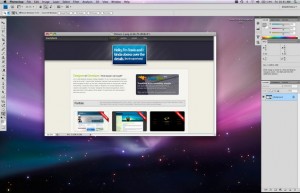Selecting Just One Object on a Layer
 If you have multiple objects on the same layer (like a few words of type that have already been rasterized) and you want to select just one item on that layer (for example, you want to put a selection around one letter so you can move it independently of the rest of the letters), here’s how: Use the lasso tool to draw a very loose selection around the object. Hold the Command key, and press the Up Arrow key once and the Down Arrow key once.
If you have multiple objects on the same layer (like a few words of type that have already been rasterized) and you want to select just one item on that layer (for example, you want to put a selection around one letter so you can move it independently of the rest of the letters), here’s how: Use the lasso tool to draw a very loose selection around the object. Hold the Command key, and press the Up Arrow key once and the Down Arrow key once.
The entire object will become perfectly selected without disturbing anything else on the layer. Now you can move it, edit it, or tweak it separately because it is now a "floating selection".
The Hidden Measurement Pop-Down Menu
You probably already know the trick the trick about entering values in measurement fields in the Options bar. You can change your unit of measure by typing in the appropriate abbreviation after the value (for example, if you want 100 pixels, you’d type in "100px"). But there’s an even easier way (and you don’t have to memorize a bunch of abbreviations). Just type in your number, Control-click in the field and a pop-up list of measurement units will appear. Just choose the one you want and it’ll take care of the rest.
View Your Layer Mask as a Rubylith
If you want to view your Layer Mask by itself (rather than how the Layer Mask affects your overall image), hold the Option key and click directly on the Layer Mask thumbnail in the Layers palette. This will display just the Mask itself. You can also view the Layer Mask like a Rubylith (a red overlay used in traditional masking) by pressing the Backslash key (\) on your keyboard.
Select Everything on Your Layer in One Click
If you have a layer that contains many objects, you can put a selection around every object on that layer by holding the Command key and clicking on that layers name in the layers palette. This is ideal in situations where you have an object that is heavily feathered or has a flattened drop shadow. If you use this trick, it will look like it only selects the most opaque portion of the image, but when you move it, youÕll find it has selected every pixel on the layer, including the soft-edged pixels Ð it wonÕt leave anything behind.
Layer Palette Navigation Speed Tips
The less you need to be in the layers palette, the better (at least when it comes to speed), so here are some shortcuts you’ll want to know: To jump to the bottom layer in the palette, press Shift-Option-Left Bracket ([). To jump to the top layer of the stack, press Shift-Option-Right Bracket (]). To move your current layer down one layer at a time, press Command-Left Bracket. To move it up one layer at a time, press Command-Right Bracket. To switch to the layer beneath your current layer, press Option-Left Bracket. To switch to the layer above your current layer, press Option-Right Bracket.


No comments
Be the first one to leave a comment.